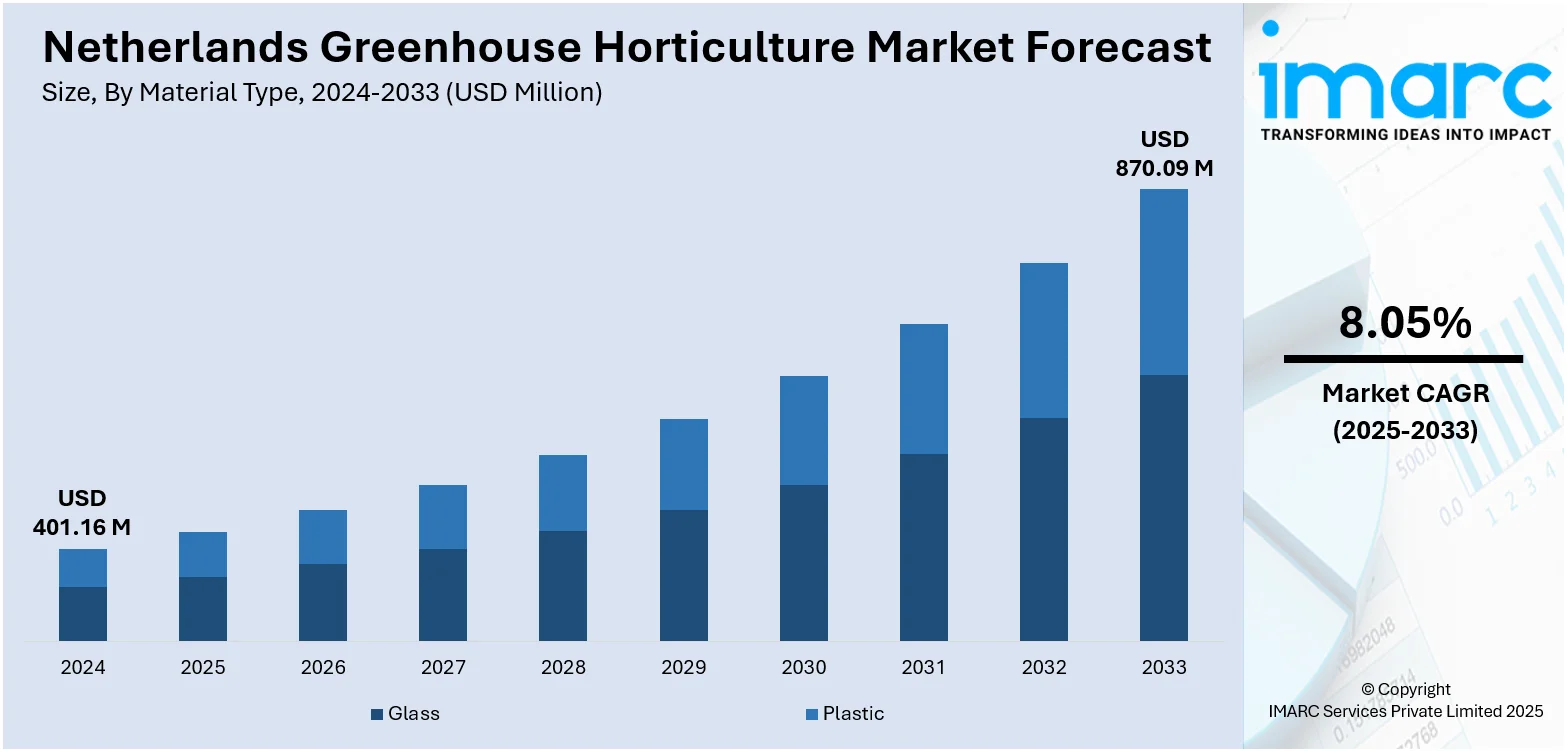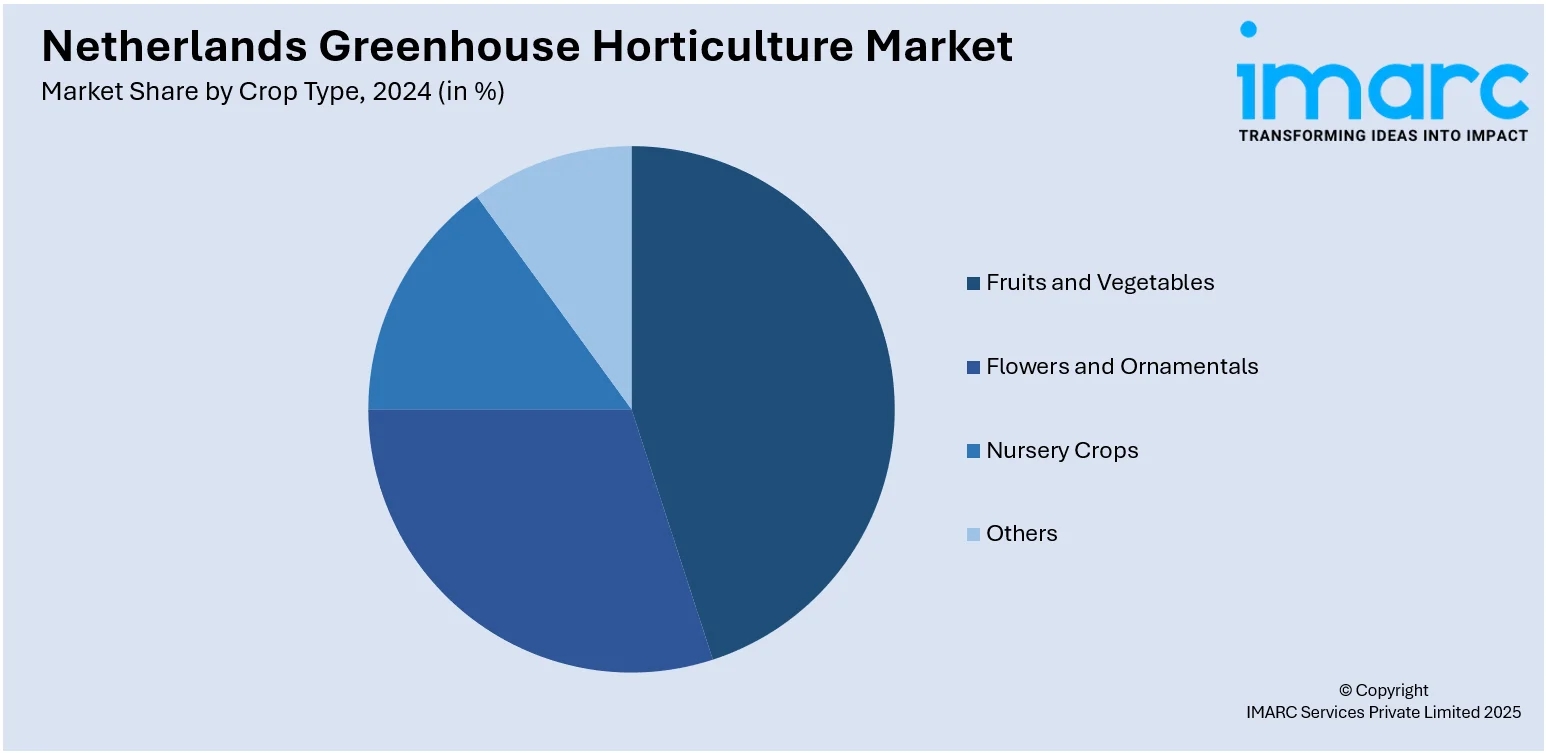
Netherlands Greenhouse Horticulture Market Size, Share, Trends and Forecast by Material Type, Crop Type, Technology, and Region, 2025-2033
Netherlands Greenhouse Horticulture Market Overview:
The Netherlands greenhouse horticulture market size reached USD 401.16 Million in 2024. The market is projected to reach USD 870.09 Million by 2033, exhibiting a growth rate (CAGR) of 8.05% during 2025-2033. The market is fueled by the country’s advanced greenhouse technology and expertise, enabling high yields and resource efficiency. Moreover, strong government support and investments in sustainable farming practices encourage the adoption of energy-efficient systems, renewable heating, and closed-loop water management. In addition to that, rising global demand for high-quality vegetables and the country's well-developed logistics infrastructure further augment the Netherlands greenhouse horticulture market share.
|
Report Attribute
|
Key Statistics
|
|---|---|
|
Base Year
|
2024
|
|
Forecast Years
|
2025-2033
|
|
Historical Years
|
2019-2024
|
| Market Size in 2024 | USD 401.16 Million |
| Market Forecast in 2033 | USD 870.09 Million |
| Market Growth Rate 2025-2033 | 8.05% |
Netherlands Greenhouse Horticulture Market Trends:
Adoption of Energy-Efficient and Climate-Neutral Technologies
Greenhouse horticulture in the Netherlands is increasingly shaped by the adoption of energy-efficient and climate-neutral technologies. Growers are integrating advanced heating systems, such as geothermal energy, residual heat recovery from industrial processes, and combined heat and power (CHP) units, to reduce dependency on natural gas. Notably, construction of the surface facilities for the Aardwarmte Polanen geothermal greenhouse project in Monster, South Holland, is progressing steadily, with installation set to continue through summer and system testing slated to commence by late 2025. The initiative, launched in 2022, will deploy geothermal heat sourced from two wells drilled to 2,300 m, supplying several greenhouse horticulture businesses via its doublet system capable of delivering water at approximately 85 °C. Moreover, LED lighting has become a dominant replacement for traditional high-pressure sodium lamps, lowering energy consumption while enabling year-round production through optimal light spectra. In addition to this, closed greenhouse concepts, which minimize heat loss and enable precise climate control, are being implemented alongside automated ventilation and shading systems. Energy screens, thermal insulation, and smart sensors further enhance efficiency by dynamically adjusting environmental parameters based on real-time data. This shift is driven by government incentives, rising energy costs, and the national goal of achieving climate neutrality by 2050. Besides this, collaborative research between universities, technology providers, and growers is accelerating innovation, allowing Dutch horticulture to maintain global leadership while aligning with environmental sustainability targets.

To get more information on this market, Request Sample
Integration of Digitalization and Precision Agriculture
The country is a global leader in horticulture, ranking as the world’s second-largest exporter of agricultural products after the United States. With the horticulture sector valued at over EUR 21 Billion, the industry plays a significant role in the national economy, with agriculture and horticulture together contributing around 10% to GDP. To remain competitive and efficient, the sector is increasingly embracing digitalization. This shift is driving the Netherlands greenhouse horticulture market growth through the adoption of precision agriculture technologies and data-driven decision-making systems. Artificial intelligence (AI) and machine learning models are being applied to optimize irrigation schedules, nutrient delivery, and pest control strategies based on real-time environmental and plant growth data. In addition to this, autonomous climate control platforms enable growers to adjust humidity, temperature, and CO₂ levels with high accuracy, improving yields while reducing input waste. Internet of Things (IoT) sensors, drones, and imaging technologies are providing continuous monitoring of plant health, detecting early signs of stress or disease before they affect productivity. Moreover, predictive analytics allows for proactive crop management, minimizing risks associated with weather fluctuations or market demand shifts. Digital twin models of greenhouses are being developed to simulate crop growth scenarios, supporting long-term planning and investment decisions. These advancements are enhancing efficiency, reducing resource usage, and allowing Dutch producers to respond quickly to shifting consumer and export market requirements.
Netherlands Greenhouse Horticulture Market Segmentation:
IMARC Group provides an analysis of the key trends in each segment of the market, along with forecasts at the country and regional levels for 2025-2033. Our report has categorized the market based on material type, crop type, and technology.
Material Type Insights:
- Glass
- Plastic
The report has provided a detailed breakup and analysis of the market based on the material type. This includes glass and plastic.
Crop Type Insights:

- Fruits and Vegetables
- Flowers and Ornamentals
- Nursery Crops
- Others
A detailed breakup and analysis of the market based on the crop type have also been provided in the report. This includes fruits and vegetables, flowers and ornamentals, nursery crops, and others.
Technology Insights:
- Heating System
- Cooling System
- Others
A detailed breakup and analysis of the market based on the technology have also been provided in the report. This includes heating system, cooling system, and others.
Regional Insights:
- Noord-Holland
- Zuid-Holland
- Noord-Brabant
- Gelderland
- Utrecht
- Others
The report has also provided a comprehensive analysis of all the major regional markets, which include Noord-Holland, Zuid-Holland, Noord-Brabant, Gelderland, Utrecht, and others.
Competitive Landscape:
The market research report has also provided a comprehensive analysis of the competitive landscape. Competitive analysis such as market structure, key player positioning, top winning strategies, competitive dashboard, and company evaluation quadrant has been covered in the report. Also, detailed profiles of all major companies have been provided.
Netherlands Greenhouse Horticulture Market News:
- In June 2025, Saudi Arabia and the Netherlands signed a suite of agreements and memoranda of understanding (MoUs) worth over SAR 428 Million (approximately USD 114 Million), aimed at advancing and localizing technologies in the environmental, water, and agricultural sectors. The 27 agreements involve partnerships between Saudi entities and Dutch organizations, targeting innovation in livestock disease control, greenhouse farming, biotechnology, crop protection, and food processing. These collaborations support technological localization and enhance agricultural productivity through international cooperation.
- The Aardwarmte Maasdijk geothermal greenhouse project celebrated the commencement of operations, with the first of its three doublets beginning to supply geothermal heat to 24 horticulture companies as of 1 March 2025. Developed through a collaboration between Warmtecoöperatie Maasdijk and HVC, the project, initiated in 2022 and with drilling completed by March 2023, aims to ultimately reach a capacity of 50 MWth.
Netherlands Greenhouse Horticulture Market Report Coverage:
| Report Features | Details |
|---|---|
| Base Year of the Analysis | 2024 |
| Historical Period | 2019-2024 |
| Forecast Period | 2025-2033 |
| Units | Million USD |
| Scope of the Report |
Exploration of Historical Trends and Market Outlook, Industry Catalysts and Challenges, Segment-Wise Historical and Future Market Assessment:
|
| Material Types Covered | Glass, Plastic |
| Crop Types Covered | Fruits and Vegetables, Flowers and Ornamentals, Nursery Crops, Others |
| Technologies Covered | Heating System, Cooling System, Others |
| Regions Covered | Noord-Holland, Zuid-Holland, Noord-Brabant, Gelderland, Utrecht, Others |
| Customization Scope | 10% Free Customization |
| Post-Sale Analyst Support | 10-12 Weeks |
| Delivery Format | PDF and Excel through Email (We can also provide the editable version of the report in PPT/Word format on special request) |
Key Questions Answered in This Report:
- How has the Netherlands greenhouse horticulture market performed so far and how will it perform in the coming years?
- What is the breakup of the Netherlands greenhouse horticulture market on the basis of material type?
- What is the breakup of the Netherlands greenhouse horticulture market on the basis of crop type?
- What is the breakup of the Netherlands greenhouse horticulture market on the basis of technology?
- What is the breakup of the Netherlands greenhouse horticulture market on the basis of region?
- What are the various stages in the value chain of the Netherlands greenhouse horticulture market?
- What are the key driving factors and challenges in the Netherlands greenhouse horticulture market?
- What is the structure of the Netherlands greenhouse horticulture market and who are the key players?
- What is the degree of competition in the Netherlands greenhouse horticulture market?
Key Benefits for Stakeholders:
- IMARC’s industry report offers a comprehensive quantitative analysis of various market segments, historical and current market trends, market forecasts, and dynamics of the Netherlands greenhouse horticulture market from 2019-2033.
- The research report provides the latest information on the market drivers, challenges, and opportunities in the Netherlands greenhouse horticulture market.
- Porter's five forces analysis assist stakeholders in assessing the impact of new entrants, competitive rivalry, supplier power, buyer power, and the threat of substitution. It helps stakeholders to analyze the level of competition within the Netherlands greenhouse horticulture industry and its attractiveness.
- Competitive landscape allows stakeholders to understand their competitive environment and provides an insight into the current positions of key players in the market.
Need more help?
- Speak to our experienced analysts for insights on the current market scenarios.
- Include additional segments and countries to customize the report as per your requirement.
- Gain an unparalleled competitive advantage in your domain by understanding how to utilize the report and positively impacting your operations and revenue.
- For further assistance, please connect with our analysts.
 Request Customization
Request Customization
 Speak to an Analyst
Speak to an Analyst
 Request Brochure
Request Brochure
 Inquire Before Buying
Inquire Before Buying




.webp)




.webp)












